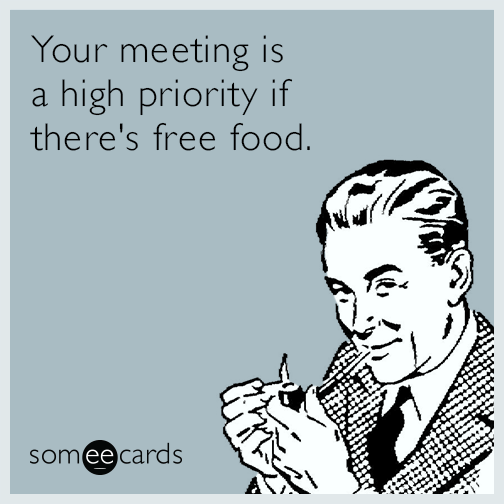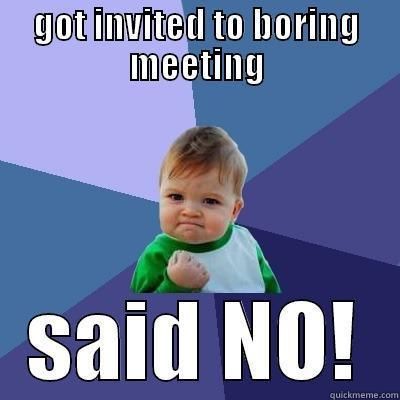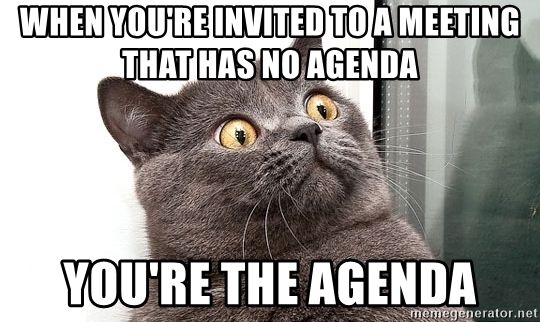8 Ways to Set Boundaries Around When You Schedule and Accept Meetings
Not all meetings are created equal. Learn 8 ways to evaluate which meetings will be a good use of your time, which will not, and how to set your boundaries accordingly.

If you leave with nothing else from this article I ask you to remember:
Not all meetings are created equal.
Meetings often end up being scheduled or accepted as soon as they hit our inbox without much thought for how they impact your schedule, or if they are worth your time and attention in the first place. Yet again we are hit with the curse of immediacy, meetings edition:
The feeling and expectation that meeting requests must be responded to and jammed into our calendars immediately.
Some meetings are awesome and worth every minute, others meetings are a complete waste of your precious time. While you can’t predict the future, you can take steps to evaluate which meetings will likely be a good use of time, which meetings will not, and set your boundaries accordingly.
The following are 8 tactics and approaches to help you make that evaluation, set the appropriate boundaries around when you schedule and accept meetings:
- Be aware of the opportunity cost of requesting or accepting a meeting
- Learn how to say no to meetings
- Take control of the act of scheduling meetings
- Schedule meetings with your energy cycles in mind
- Group your meetings on certain days and time slots
- Schedule meetings for shorter time blocks
- Ensure your meetings have agendas
- Turn your meeting into an email by writing an agenda
8 ways to set boundaries around when you schedule and accept meetings
Instead of letting meetings happen to you, you can set boundaries around your time and availability to make sure the meetings you do attend are valuable and you attend fewer ones that aren’t!
1. Be aware of the opportunity cost of accepting or requesting a meeting
If someone randomly asked you for $500, you would probably think twice about saying yes. But what if that same someone asked you for a coffee meeting? Most people almost always say yes to a coffee meeting, but don’t consider the opportunity cost of this time.
Depending on how your compensation works, a coffee meeting could easily “cost” you over $500 worth of time, energy, and focus! Before you automatically say yes to one of those meetings ask yourself:
- How much is my time worth?
- Is this a good investment of my time?
- Does this meeting fit within my priorities and goals?
- What is the purpose of this meeting and who does it benefit?
I’m not saying you shouldn’t accept or request coffee meetings, which can be great for networking, sales, relationship building, and just plain fun. Sometimes you just want to hang out with someone! Rather, it is worth a few minutes to think about:
- What could I do with that time instead of going to a meeting?
- What about the time taken to travel somewhere?
- What about the “dead” time between meetings?
- If I accept this meeting, how does it impact the rest of my day and week?
The same questions apply to any other type of meeting AND when you ask others for meetings. Consider:
- Could this meeting be an email (more on this in section 8)?
- If I ask for this meeting, how does it impact the rest of my day and week?
I am not saying all meetings are a waste of time or you shouldn’t be social. But take a minute to think through these questions, and you can save yourself (and others!) that high opportunity cost when a meeting is not a good use of time.

2. Learn how to say no (or not now) to meetings
So you get a meeting request that you are:
- Not sure you want to take;
- Don’t want to take at all; or
- You would like to take it but your calendar is so packed already you know it will disrupt your schedule.
What now? (lift the curse)
First of all, ask for an agenda to get more information, which you can use to make a decision about whether or not the meeting is a good investment. Send something like:
Thanks for the invite to the meeting on Thursday. I'd like to get a better understanding of my contribution because my schedule is a little tight right now, and I want to make sure it makes sense for me to attend. Do you mind passing along an agenda?
If you decide it’s not a good use of your time, try something like:
Thanks for the additional info. My schedule is full right now so I, unfortunately, won’t be able to attend. Can you please send me the meeting minutes following the meeting?
Or:
Thanks for the invite. I am in the middle of a big project and not able to accept any more meetings for the time being. However, feel free to email me the meeting minutes afterwards as well as any questions you may have.

If it’s a meeting you are interested in but don’t really have space for, you are allowed to say, yes, but not now. Try things like:
I’m happy to chat about this with you. Can it wait and be included in the team meeting on Tuesday?
Or :
Thanks for thinking of me. I am booked up until [x date] but would be happy to schedule something during the week of [x date]. Here are a few times I am available…
Check out my post, Obligation Elimination and the Power of Saying No, for more on learning to say no!
3. Take control of the act of scheduling meetings
Few things annoy me more than when someone sends me an email and asks, “When are you available?”, with no time or date suggestions. It is the start of an inevitable stream of 10 emails as you each do the dance of scheduling... which is a waste for everyone!
Instead of asking someone when they are available, you can take control of the act of scheduling:
- Propose your ideal time, date, and location options in your first email.
You get to choose what works best for you after considering your current schedule. It puts the onus on the other person to choose from the options you provided, while still giving them choice. - Use an app like Calendly. I love Calendly. It has been a huge time saver for me. It syncs with your calendar and you can customize when you are available and when you are not (among dozens of other details). You send the link with your meeting preferences built-in and the person you are contacting books a time. Boom💥. 10 email stream prevented.
- Create a templated response you can bust out when you are scheduling new meetings. My go-to is:
....I will propose [x day at x time]. If that doesn’t work for you, please take a look at my schedule and book a more convenient time. I look forward to connecting. Thanks!
I can’t tell you how many emails this has saved me (and the people I’m scheduling with)!
4. Schedule meetings with your energy cycles in mind
When you think about your ideal time for meetings, just like I mentioned for email, think about your energy cycles and ask yourself:
- What is my most productive time for deep thinking? Try not to schedule meetings during this time.
- Do meetings usually drain me or energize me? Are you introverted or extroverted? If you are extroverted, meetings will give you energy and pump you up a little. If you are introverted, they will do the opposite and drain you. Introverts in particular need to be intentional about meetings to try to safeguard their energy.
- What other regular commitments happen in my week that I should keep in mind? Consider things like your regular recurring meetings or the pickup time for your kids. For example, I like to work out every day around 11:30 and then have lunch. I try not to schedule meetings around this time (though it is not always possible).
- What is my lowest mental energy part of the day? I suggest you schedule meetings during this time. Meetings require a different kind of energy and focus than deep thinking and they can help you get through the low parts of the day.

5. Group your meetings on certain days and time slots
I think of this as creating protected time. By grouping your meetings into certain days and time slots, you are making the intentional decision to leave other parts of your schedule available for other kinds of work.
A meeting usually isn’t just that 1 hour. It often has 15 minutes of dead time before and after, not to mention commutes if you are meeting in person, or meeting summary emails, or any of the other tasks that pop up around meetings. Instead of having random meetings scattered throughout your day or week with all that extra time lost, schedule your meetings in groups.
For example, I like to group my meetings on Tuesday, Wednesday, and Thursday afternoons, after 1:30 pm. My best deep thinking time is in the morning and my worst deep thinking time is in the afternoon. By then I am done with my workout and lunch and ready for the next phase of work. I also rarely take meetings on Fridays because I like having at least one day a week that is meeting-free.
6. Schedule meetings for shorter time blocks
Not all meetings have to be an hour, nor do they have to be scheduled on the hour. Whoa, crazy right? You can choose to schedule meetings for shorter time blocks. The nice thing about shorter meetings is they encourage you to get right down to the point and have a focussed conversation since all parties are aware that the time is limited.
Specifically for Zoom meetings, I am a big fan of meetings that are 30 or 45-minutes long:
- 30-minute meetings are great for a consultation or a meet-and-greet. You have enough time to connect, but they don’t take up too much time in your day.
- 45-minute meetings give you a bit more space but also allow you a break between back-to-back meetings so you have time to stretch, get some water, and have a bathroom break!

7. Ensure your meetings have agendas
Oof, this is an important one! Most meetings should have an agenda. Full stop. That agenda should be sent before the meeting. And not 3 minutes before. At least an hour, and more if possible and depending on the nature of the meeting. Why? Because meetings are most productive when the people attending know why they are there and have had time to prepare!
Sending an agenda prior to a meeting:
- Gives the person who has called the meeting the opportunity to collect their thoughts and get clarity on what they want to cover and the desired outcome.
- Gives the people attending the opportunity to prepare and start thinking about discussion items or anything they need to present on.
There is nothing worse than showing up at a meeting not entirely sure why you are there and wasting the first 20 minutes finding out. Instead, send an agenda so that people can prepare, you can skip the preamble, and get right down to business.
You can check out my article, Optimize Your Meetings with Meeting Rhythms and Agendas to learn more and even try a handy template.
Also, shameless plug for Tadum to build your agendas and manage your meetings. It is a meeting agenda and minutes app that I co-founded that helps teams get organized and stay accountable by automating agenda and minutes preparation. I LOVE it, but I am also a bit biased.😉
Casual coffee meetings don’t need a formal agenda but there is still benefit to having clarity on the purpose of the meeting and the outcomes each party is hoping to achieve. In the case of a coffee meeting, simply ask!
Thanks for the meeting invite! Did you have anything specific you wanted to discuss?

8. Turn your meeting into an email by writing an agenda
Nothing is worse than going to a meeting that should have been an email or where there isn’t really much to go over. Recurring meetings are particularly bad for this. Recurring meetings are awesome for making sure you are connecting regularly on a project or with your team, but sometimes just because it’s booked in your calendar, doesn’t mean it has to happen.
A good way to find out if a meeting (of any type) is necessary is to create that agenda! Sometimes writing the agenda will reveal:
- There isn’t much to go over; or
- An update could be easily sent out via email.
In both cases, the meeting should be cancelled giving everyone an unexpected block of open time.
We have all attended a meeting that should have been an email and the corresponding feeling of frustration at having wasted that time. Instead, give everyone the opposite feeling of opportunity at getting a bit of time back!

Side note: I realize there is a social and culture benefit to connecting at regular meetings. I’m not saying cancel everything, just be aware of what is a good use of time and what the other opportunities for connection are in the team.
Like email, some of you will have more control over your meeting schedule than others... but you still have more control than you think! The curse of immediacy and jamming a million meetings into our schedules have been so ingrained that it can be a tough one to break, but it’s possible!
These tactics are about keeping in mind the opportunity costs of meeting and thinking through how each meeting will impact your schedule, given the other responsibilities and commitments of your day or week. Again, you will not be able to do ALL THE THINGS. But try one or two.
What is one change you will make to set some boundaries around meetings?
What other meeting boundary-setting tactics do you use?
Need some more help setting time boundaries?
- Read 7 Ways to Set Email Boundaries and Lift the Curse of Immediacy.
- Read my past articles.
- Learn about my one-on-one coaching
Share
Ashley Janssen

Productivity consultant, writer, speaker, serial entrepreneur, chaos calmer, introvert, cat-lady. Lover of books, fitness, old fashioned’s, basketball, and video games.
Follow me on
Twitter
or
LinkedIn.
Hire me for
1 on 1 productivity consulting
or
speaking.
Related articles

7 Rules For An Effective Meeting Culture

Debunking The False Promises of Productivity


Comments ()